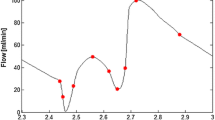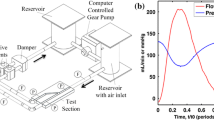Abstract
Local flow alterations created by a metallic stent in a simulated coronary artery were studied to compare the hemodynamic effects of two different stent geometries. Dye injection flow visualization and computational fluid dynamics were used. Resting and exercise conditions were studied. Flow visualization using the dye injection method provided a qualitative picture of stent hemodynamics while the computational approach provided detailed quantitative information on the flow next to the vessel wall near the intersections of stent wires. Dye injection visualization revealed that more dye became entrapped between the wires where the wire spacing was smallest. The dye washout times were shorter under exercise conditions for both wire spacings tested. The computational results showed that stagnation zones were continuous from one wire to the next when the wire spacing was small. Results from greater wire spacing (more than six wire diameters) showed that the stagnation zones were separate for at least part of the cardiac cycle. The sizes of the stagnation zones were larger under exercise conditions, and the largest stagnation zones were observed distal to the stent. These studies demonstrate that stent geometry has a significant effect on local hemodynamics. The observation that fluid stagnation is continuous in stents with wire spacings of less than six wire diameters may provide a criterion for future stent design. © 2000 Biomedical Engineering Society.
PAC00: 8719Uv, 8719Hh, 8780-y
Similar content being viewed by others
REFERENCES
1_ Berry, J. L., J. E. Moore, V. S. Newman, and W. D. Routh. In vitro flow visualization in stented arterial segments. J. Vasc. Invest.3:63-68, 1997.
2_ He, X., and D. N. Ku. Pulsatile flow in the human left coronary artery bifurcation: Average conditions. J. Biomech. Eng.118:74-82, 1996.
3_ Ku, D. N., D. P. Giddens, C. K. Zarins, and S. Glagov. Pulsatile flow and atherosclerosis in the human carotid bifurcation: Positive correlation between plaque location and low and oscillating shear stress. Arteriosclerosis (Dallas)5:293-302, 1985.
4_ Moore, J. E., C. Xu, S. Glagov, C. K. Zarins, and D. N. Ku. Fluid wall shear stress measurements in a model of the human abdominal aorta: Oscillatory behavior and the relationship to atheroscelerosis. Atherosclerosis (Berlin)110:225-240, 1994.
5_ Munson, B. R., D. F. Young, and T. H. Okiishi. In: Fundamentals of Fluid Mechanics. 3rd ed., New York: Wiley, 1994, p. 320.
6_ Noledge, G., V. Siegestetter, G. M. Richter, R. Bohn, M. Franke, A. Eckert, and J. C. Palmaz. Palmaz stent: Process of neointima formation in conditions of highly impaired flow. Radiologic Society of North America Meeting, Chicago, IL, 1989.
7_ Rhee, K., and J. M. Tarbell. A study of the wall shear rate distribution near the end-to-end anastomosis of a rigid graft and compliant artery. J. Biomech.27:329-338, 1994.
8_ Rogers, C., and E. R. Edelman. Endovascular stent design dictates experimental restenosis and thrombosis. Circulation91:2995-3001, 1995.
9_ Tominaga, R., H. E. Kambic, H. Emoto, H. Harasaki, C. Sutton, and J. Hollman. Effects of design geometry of intravascular endoprostheses on stenosis rate in normal rabbits. Am. Heart J.123:21-28, 1992.
Author information
Authors and Affiliations
Rights and permissions
About this article
Cite this article
Berry, J.L., Santamarina, A., Moore, J.E. et al. Experimental and Computational Flow Evaluation of Coronary Stents. Annals of Biomedical Engineering 28, 386–398 (2000). https://doi.org/10.1114/1.276
Issue Date:
DOI: https://doi.org/10.1114/1.276




